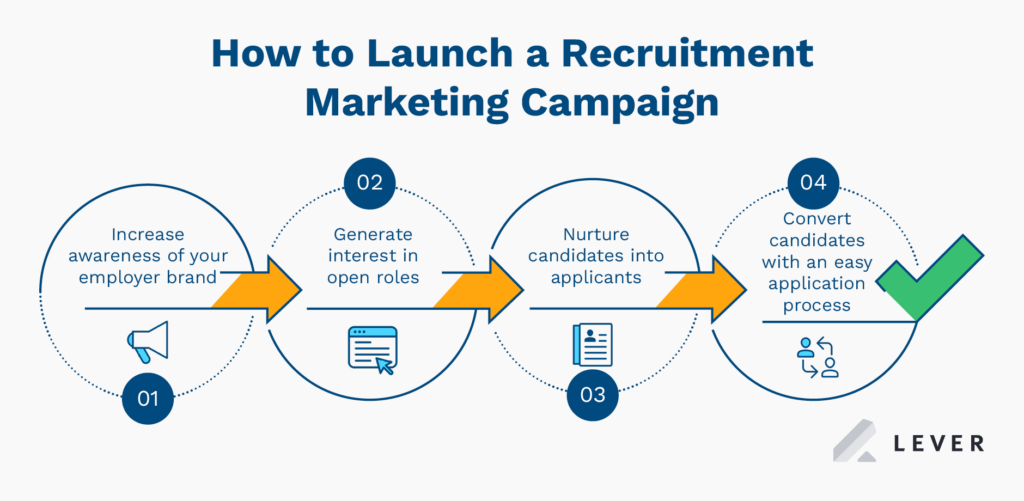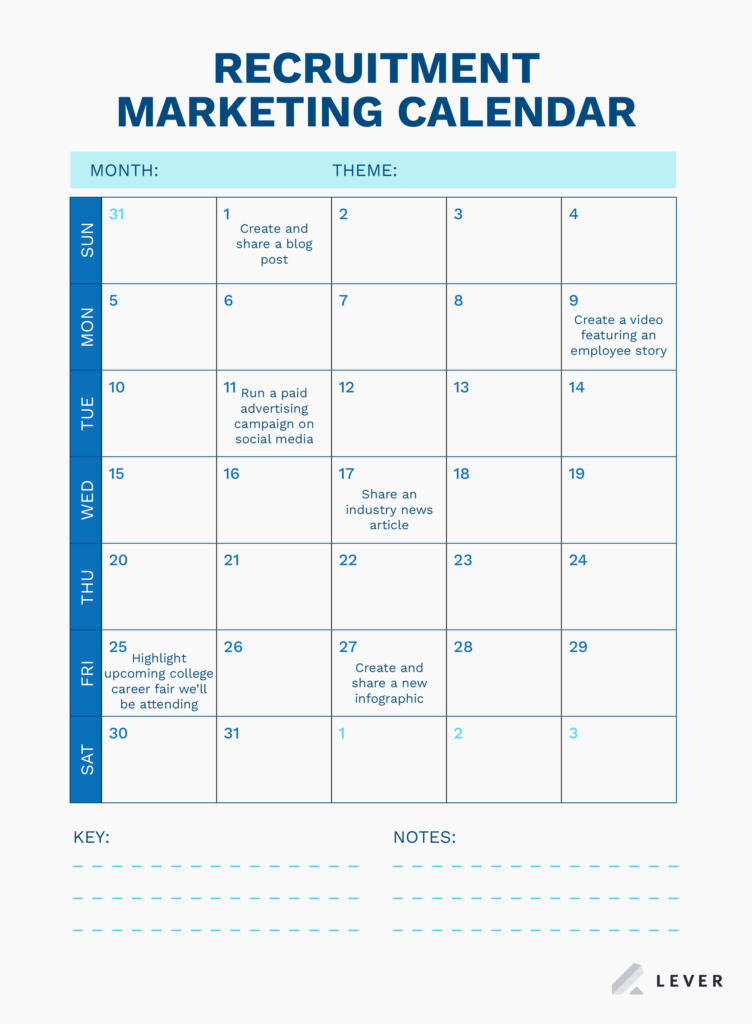Building a team of diverse talent with a wide array of perspectives, ideas, and skillsets from a variety of backgrounds is vital for the growth and success of any organization.
That said, sourcing, nurturing, and hiring the right people to join your company is one of the most challenging aspects of running a business today.
But this process is quite similar to the work your marketing team does to attract customers for your business. It’s called recruitment marketing.
In this guide, we’ll review everything your talent acquisition (TA) team needs to know about recruitment marketing, so you can strengthen your employer brand and reach the best job candidates.
- What is recruitment marketing?
- 4 stages of a recruitment marketing campaign
- How to level up a recruitment marketing campaign
- 4 helpful recruitment marketing ideas

What is recruitment marketing?
Recruitment marketing is a set of marketing strategies and tactics to promote open roles and your employer brand as a whole to candidates.
Done effectively, recruitment marketing increases visibility into your company culture and builds a robust talent pool, which can help you attract and engage high-quality candidates.
Recruitment marketing extends far beyond sourcing candidates. It applies to the entire talent acquisition lifecycle — from attracting potential candidates to engaging and nurturing that talent throughout the recruitment funnel.
Recruitment marketing involves some unique strategies that differ from other types of marketing, which are highlighted in the next section.
4 stages of a recruitment marketing campaign

Increase awareness of your employer brand
While top-of-funnel candidates can be sourced virually anywhere, many job seekers are passive. That means they are currently employed, but open to new roles or opportunities — and likely don’t know much about your employer brand yet.
To attract the right talent, you need to market your organization not only to active job seekers, but also to passive ones. This means promoting your business in communities where passive prospects are active. This involves creating shareable content that helps drive awareness of your company to target candidates, including:
- Blog posts
- Videos
- Infographics
Once you’ve nailed down the types of content you want to produce, determine which channels you’ll use. Social media sites like LinkedIn, your website, and job boards are great places to spread the word about your employer brand. Ensure that you curate your content to the channel you post it on — long-form text-based content, for instance, would fit better on your blog than on social media.
Generate interest in open roles
Once you have the attention of passive and active candidates, focus on providing these prospects with insights that will increase their interest in your organization. To support your efforts, make sure you:
- Get stories and quotes from current employees about what it’s like to work in your company
- Spread awareness of what makes working at your company special, including volunteer days, tuition reimbursement, flexible scheduling, corporate philanthropy programs, and other unique aspects
- Develop interactive content, such as quizzes, infographics, and more to get potential hires invested in the posting
Along with implementing these tactics, the key to generating interest is to ensure that your recruiting team is aligning on the content you’ll create, how you’ll distribute it, and the frequency at which you’ll produce it to align with candidate preferences.
Nurture candidates into applicants
As candidates show greater interest in your organization, encourage them to join your team. This process, known as nurturing, is a step further down the marketing funnel because it involves building personal connections with candidates and sharing more detailed information about the organization’s culture.
For example, many prospects want to know about:
- DEI initiatives
- Sustainability commitments
- Benefits and perks programs
- Growth and development opportunities
- Company culture
Feature these details prominently in employer brand messaging through your outreach channels. You can take your nurturing efforts a step further by having current employees reach out as points of contact to build relationships with candidates.
Convert candidates with an easy application process
The reality of recruitment is many job seekers don’t end up applying for a job that once piqued their interest. This makes it vital to make the application process as seamless as possible.
If you have a modern applicant tracking system (ATS) in your TA tech stack, applicants can easily fill out job applications in a matter of minutes and with just a few clicks.
Even if a candidate makes it to this stage, but chooses not to apply yet, don’t worry. This is a great opportunity to grow your talent pool and start building relationships with talent who may want to apply in the future.
Once you’ve successfully ushered prospects through the recruitment marketing funnel, assess which channels and strategies worked better than others. This information will help you capitalize on successful ideas and determine areas for improvement.
How to level up a recruitment marketing campaign
Use TA tools to optimize recruitment marketing channels
Identifying the right channels to leverage for your recruitment marketing helps you allocate resources efficiently and boost visibility. Use tools specifically tailored for TA to support your recruitment marketing efforts. For example, look for tools that can:
- Empower TA teams to market roles to diverse candidate pools
- Segment communications based on the candidate’s relationship with your organization
- Determine how to reach applicants for hyper-specific jobs
Whatever demographics you’re looking to target, using tools custom-made for your purposes, like Lever, will help your teams quickly reach qualified talent.
Articulate your employer brand identity
Before developing a recruitment marketing strategy, you’ll need to align your team with your employer brand. That’s because employer branding is necessary for marketing your organization and reaching your target audience. Your employer brand comprises elements like your:
- Employee value proposition
- Company mission and values statement
- Company culture
- Employee engagement initiatives
All of these elements should be front and center in your recruitment marketing collateral, so it resonates with like-minded candidates. Once you have your employer brand in place, you can focus on developing a recruitment marketing program that helps you hire top talent.
Set specific goals for your promotional efforts
Just as you set goals for your TA strategy, you will only be successful with your recruitment marketing efforts if you have clear and measurable objectives tied to it.
When setting your goals, keep the SMART (specific, measurable, achievable, relevant, and time-bound) framework in mind. For instance, let’s say your organization is trying to overhaul your recruitment marketing strategy. A SMART goal might look like this:
“Increase the number of qualified candidates applying through our career site by 30% within the next year by using paid search ads, improving job descriptions, and referring people through other channels.”
Ensure all of your goals are aligned with this level of specificity, so you can stay on track throughout the marketing process.
Define clear roles and responsibilities
Defining roles in advance ensures that everyone understands what they’re responsible for and there aren’t any gaps in your marketing workflow. Consider adding these roles if budgeting allows to optimize your recruitment marketing efforts:
- Content publishing coordinator
- Marketing copywriter
- Sourcing specialist
- Recruitment marketing data analyst
- Recruitment marketing lead
Be sure your entire TA team is aligned on the distinct roles they play in your recruitment marketing, so you can continually make progress and provide a positive candidate experience.
Identify resources and capacity for your strategy
Whether your TA team has 20 people or two, allocating resources efficiently is critical for sustainable growth, especially in challenging job climates.
That means you may need to start with more affordable recruitment marketing channels before sinking money into larger campaigns. Start by testing employer brand and role-centric messaging on a few proven channels, such as email.
Then, work your way up to more frequent and varied content development and social media management. Once you feel comfortable investing more time and money into your efforts, optimize those that have the most potential to reach the most qualified candidates.
Create a calendar to track marketing activities
Knowing how, when, why, and where you work on and post content can determine how successful your candidate engagement efforts really are. However, juggling content for multiple channels can be a challenge.
That’s where an editorial calendar, like this one, can help you organize your efforts:

Create a calendar that lists the types and formats of content you plan to develop, timelines for posting content, detailed overviews of who the content is geared toward, often referred to as personas, and which channels you’ll be leveraging.
4 helpful recruitment marketing ideas
Consider organic and paid advertising
Channels like social media are critical to your employer branding strategy. But using them to market your roles and company culture presents a unique challenge because not all social platforms are suited for recruitment marketing. That’s why it’s critical to know where your target candidates are spending their time.
For example, LinkedIn Recruiter may be a highly effective paid recruitment marketing channel that enables your team to target their main user base, Millennials. On the other hand, posting organically via Instagram could be your path to connect with and convert more Gen Z candidates who aren’t on LinkedIn or who aren’t using it as often as older workers.
You can use qualities like your target audience’s age, tech-savviness, and workforce experience to pick your channels and whether you’ll leverage an organic or paid strategy.
Take advantage of your website
One of your greatest resources for recruitment marketing is your website, specifically your Careers page, About Us page, and blog. These owned elements of your site are perfect for promoting your employer brand.
Don’t be afraid to ask your marketing team for help in creating landing pages on your company’s site where you can promote brand and culture content, and even help with writing job descriptions that are compelling and better attract job seekers.
Develop internal subject matter experts
Your organization’s online profiles on job boards, career communities, and social media can help you get in front of top-tier talent. That said, internal subject matter experts (SMEs) can also help bolster your company’s reputation through sharing brand content and marketing open roles across your business.
You can develop internal SMEs by supporting leaders and other colleagues in creating thought leadership content and positioning these individuals as experts in their respective roles on public-facing platforms. Or, you can invest in your SME strategy by sponsoring team members to attend conferences and get higher levels of education and certifications.
Use newsletters to attract and engage leads
With its unbeatable 4,200% ROI, email should definitely be a part of your recruitment marketing strategy. Engage potential candidates and spread awareness of your employer brand by creating email newsletters. With the help of an ATS that supports segmented sending and templates, your team can quickly create newsletters without compromising personalization and quality.
Remember to keep your email marketing campaign going strong past the first newsletter. After all, according to Lever’s 2022 Talent Benchmarks Report, there’s a 450% higher response rate for six- and seven-email campaigns.
Recruitment marketing: Next steps
As you build relationships with candidates, stay top of mind with them by touching base frequently. That way, the next time they actively seek a new role, your brand has a better chance of standing out from competing employers. Communicate relevant information such as business updates, new executives you hire, events you’re hosting, and — of course — the latest open roles to keep candidates engaged and interested in the long haul.
Learn how you can accelerate your recruitment marketing strategy and better convert high-quality candidates with Lever’s complete ATS + CRM solution. Talk with our team today.


